Tools of the Trade: A Peek Inside the Bog-Coring Lab of Dorothy Peteet
What’s a bog corer? And how do seeds help scientists learn about the earth’s past? A paleoecologist explains the most important items in her toolkit.
Tools of the Trade is a new series that brings you inside the labs of Earth Institute scientists. Learn about the equipment scientists are using, and discover how those tools are used in their research. In this first installment of the series, learn about the bog-coring lab and research of paleoecologist Dorothy Peteet.
Dorothy Peteet, a research scientist, botanist, paleoecologist, and seed-lover, is dragging a six-foot-long tube of metal out of a crowded storage room. This is one of three corers she’s showing me, the biggest one, which she uses for bogs. It’s made of steel, but it’s not stainless, and although she always cleans it when she puts it back in storage, she still has to meticulously sand it down to rid it of rust every time she wants to use it to core a bog. It’s made to order in Finland at one of only a few places that constructs these important tools.
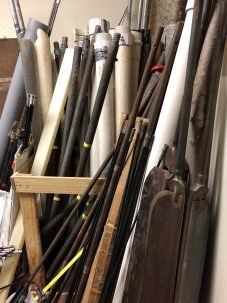
What is “coring” and why is it important?
So, what does it mean to “core” a bog? To “core” in this case means to take a vertical sample of earth. It describes the physical act of pushing a metal tube down into the ground and bringing it back up full of, well… dirt. Or mud, depending on how wet the earth is that you’re coring. This can be—and is—done anywhere: the bottom of the ocean, the side of a mountain, the bed of a stream. It’s somewhat like the trick that children and bartenders use to grab liquid from a drink using a straw: stick the straw in the liquid, put a finger over the top, and bring it back up again full of liquid.
Peteet focuses on coring wetlands such as bogs and marshes. Wetlands are extremely important because of their unique ecosystems—many species that live in wetlands do not exist anywhere else. Bogs in particular also store an amazing amount of carbon; they are formed by layers upon layers of partially decayed plant material that have built up over thousands of years, becoming peat.
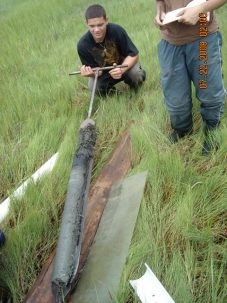
On field expeditions, Peteet and her students push the corer down into the earth, lined with a PVC tube (the kind you can buy at Home Depot), and bring it back up filled with evidence about the past. Then they slide the PVC tube of mud out of the metal corer and cap it. Once Peteet has one of these core samples, she brings it back to her lab on the campus of the Lamont-Doherty Earth Observatory. Here, there are numerous ways she can analyze the contents of the sample, all of which will tell her details about the history of its home environment.
Back at the lab
Which analyses Peteet decides to run depend on what types of questions she’s trying to answer. For instance, to study why Jamaica Bay’s salt marshes are eroding, Peteet and her team took two cores of the marshes and studied both the organic and inorganic components. In another project, Peteet used pollen records to track how climate change has affected New York State’s plants and animals.
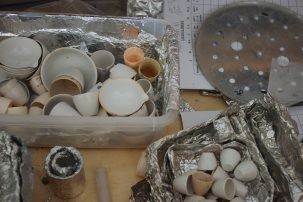
In one project for NASA, she’s studying the pollution history of Long Island Sound, including heavy metals (like lead, copper, and zinc) and nitrogen (from fertilizer and sewage), as well as the carbon exchange between the marshes and the Sound. NASA’s satellite data of the Sound only goes back 50 years, Peteet explains, but by coring the top meter of soil, she can reconstruct a much deeper history. The top meter represents about 400 years, she says, “and we can tell from the lead that 50 centimeters [down] is about the middle of the 1800s.” The history of when leaded fuel was introduced and then removed from market is well-documented, so it’s easy to date the Long Island cores based on where the lead content begins and dramatically reduces.
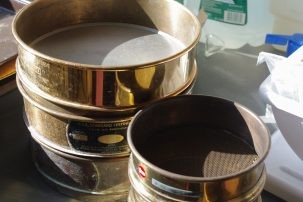
In one drawer, she shows me the small ceramic bowls she and her students use to burn samples. “One thing we do with these cute little cups is we take 1cc of sediment and burn it, and see how much organic material—plant matter—is in it.” By burning the samples and measuring the results, they can test how much carbon is being stored. “We want to see through time, how much are the marshes storing,” she says, and how it’s affecting the Sound.
On the other side of the room, Peteet points out sieves with fine mesh screens, called fraction screens. Here is where she and her students sift through slightly larger samples, about 5cm slices cut from the core, and look for plant macrofossils and foraminifera (she calls them “forams,” familiarly). Foraminifera are “one-celled animals” with shells, found in water and wetlands, especially in marine environments. Both forams and plant parts are abundantly found as fossils in salt marsh cores, like the cores they would take from the Long Island Sound marshes. Peteet and her students carefully pick through their findings and categorize them, looking at the frequency of different species over time and location.
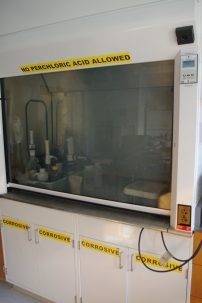
“The pollen is what takes a really long time.” Peteet walks me back to the other side of the room where there’s a plexiglass protected chemical fume hood. She explains, “It takes two days to process 12 samples because you’re boiling, centrifuging, and getting rid of everything but the pollen, and it takes all these acids. This hood is rated the highest in terms of chemicals for the whole building because we use hydrofluoric, hydrochloric, and sulfuric acids. Pollen is [one of the] most resistant organic material[s] on earth. The cell wall is very hard, and you’re basically destroying everything but that. Then we take one drop of that pollen and put it on a slide and count 300 pollen grains per slide. It takes me about two hours to count one slide.”
Pollen grains viewed under a microscope can tell Peteet generally about the types of plants in and around the core sample area.
Seeds tell all
What pollen can’t tell Peteet is what species it is from; many plants of related species have pollen that looks identical, or only varies slightly in size.
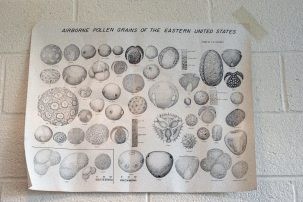
This brings Peteet—a botanist—to the resource she’s most excited about: her seed library. When she and her colleagues and students screen cores, they often find seeds in the layers. Seeds, unlike pollen grains, are always unique to their species, so if there are seeds in a sample, it makes it that much easier to learn about that particular sample’s home location.
Peteet saves seed samples from every field expedition she goes on, building up a significant—and one of the rarest—reference collections of seeds in the US. In her office there is a dark wood chest of shallow drawers, which are filled with small vials of seeds. Peteet studies them closely under the microscope, learning the subtle differences between species. “I make little slides with each little piece, a leaf on both sides and seeds,” she says, so when she or a colleague finds a seed in a core, they can use the slides to identify it.
a" data-cycle-paused="true" data-cycle-prev="#gslideshow_prev" data-cycle-next="#gslideshow_next" data-cycle-pager="#gslideshow_pager" data-cycle-pager-template=" " data-cycle-speed="750" data-cycle-caption="#gslideshow_captions" data-cycle-caption-template="{{cycleCaption}}" > <►>Seeds from the phragmites family, which consists of grasses and reeds found in wetlands. Photo by Dorothy Peteet.And then there are plants that don’t have seeds, like mosses and bulrushes. “Mosses are hard. But I have a lot of books.” It is true; Peteet’s office walls are lined with books about mosses, the flora of Alaska, seeds, marsh plants, and plants of the Cenozoic era. These are necessary, she says, because there is no online reference database for plants—yet.
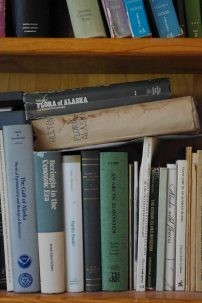
A colleague of Peteet’s, Lamont associate research professor John Nichols, does chemical analyses of pollen and other plant parts. Peteet excitedly tells me that Nichols is making a “chemical dictionary” of the sedges (bulrushes are a part of the sedge family). With a tool like that, Peteet could chemically analyze pollen herself and learn what species it is from, even without having the seeds to reference. “We’re always improving,” she says with a smile.
Peteet quite clearly loves the work she’s doing, and she loves to pass on her knowledge to her students. “This high school student wanted a project in the Catskills, so we went and cored a seven-meter bog. We spent hours with this collection trying to identify the things she was finding. It was really fun,” she says.
But her passion comes in part from frustration. Humans “frame a lot of things in terms of their value to humans rather than their intrinsic value,” she says, lamenting the tendency to drain and develop unique wetland ecosystems, destroying them in the process. “It’s hard to get people to value things. Like, what’s the value of a Great Blue Heron, or reading to your children? We don’t put any of that in our calculations, and yet it’s what makes life wonderful.”
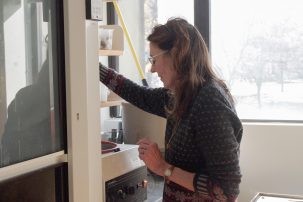
Peteet will continue to teach those lucky students that get to share in her passion. Right now she’s teaching a class called the Environmental History of New York in partnership with Nichols and the Archaeology Department at Columbia. “Tomorrow I’m going to teach the class, and I’ll take a piece of a core that we have and screen it and then give them each a petri dish, and give them some tweezers and they’ll pick out things,” she tells me excitedly. She’ll share her seed library with them, in hopes that perhaps they will make a connection, learn about the past, and grow to understand the intrinsic value of the environment around them.
All photos by Phebe Pierson, except where otherwise noted.
